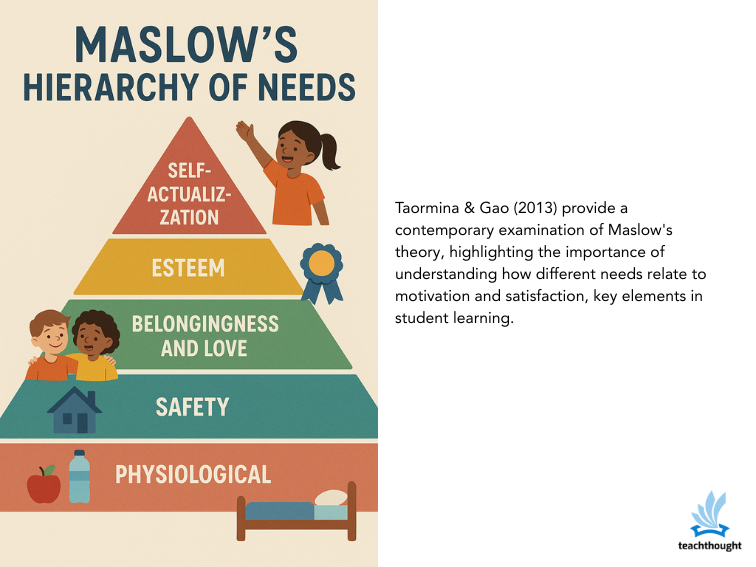Teaching strategies for the hierarchy of Maslow needs
by Staff
The hierarchy of Maslow’s needs, developed by psychologist Abraham Maslow in 1943, is a fundamental theory in psychology that describes the stages of human needs as a pyramid, with the most basic needs below and more advanced needs at the top.
Individuals must meet lower level needs before they can focus adequately on higher needs.
Let us synthetize information on the hierarchy of Maslow needs for your public educator from kindergarten to 12th year, incorporating the research quotes you have requested.
Understand and apply the hierarchy of Maslow’s needs in class K-12
Maslow’s hierarchy of needsDeveloped by psychologist Abraham Maslow in 1943, provides a powerful framework to understand the basic needs that stimulate human behavior and motivation.
This model, often represented as a pyramid, suggests that individuals must meet lower level needs before they can focus adequately on higher level needs. For educators from kindergarten to 12th year, understanding this hierarchy is crucial to creating a favorable and effective learning environment where all students can have the best chances of learning and growing.

The five levels of the Maslow hierarchy and their relevance for students
Physiological needs: These are the most basic needs of survival. For students, this translates to their needs for hunger, thirst, rest, heat and basic health. Students who are hungry, tired or sick will find it difficult to concentrate and learn effectively.
For educators: be attentive to the signs of unsatisfied physiological needs. Offer access to water, allow movement breaks and be aware of resources within the school to support students confronted with these challenges.
Security needs: Once the physiological needs are satisfied, students must feel safe, both physically and emotionally. This includes a predictable and ordered school environment, without threats, as well as a classroom where they feel accepted and respected.
For educators: establish clear routines and expectations, create a positive and predictable class climate and quickly approach all cases of intimidation or harassment.
Needs for love and belonging: This level implies the need for social connection, acceptance and to feel part of a group. For students, it means having the opportunity to establish positive relationships with its peers and feel a feeling of community in class and school.
For educators: promote a sense of community through collaborative activities, encourage positive interactions and create an inclusive environment where each student feels valued and as if they belong.
See also 50 of the best quotes on teaching
Esteem needs: Once students feel a sense of belonging, they must develop self -esteem and confidence. This includes feeling good about themselves, receiving respect for others and feeling a feeling of success and competence.
For educators: offer students the opportunity to live success, to offer specific and positive comments, to celebrate effort and progress and to help students recognize their forces.
Self-actualization needs: It is the highest level and consists in achieving its full potential, continuing personal growth and trying to become the best version of oneself. For students, this can manifest itself as a desire for creativity, problem solving and continuous learning.
For educators: encourage students to explore their interests, offer opportunities for creative expression and difficult tasks and to promote a love of learning that supports their individual growth.
Recognize and respond to unsatisfied needs in class:
Observation of students’ behavior can provide precious clues to their unmet needs. For example, a student who frequently complains of hunger or fatigue can have unsatisfied physiological needs. A student with anxiety about changes or constant reassurance research could have unsatisfied security needs. Social isolation or attention research behaviors could indicate a lack of belonging, while low self -confidence or reluctance to try new things could indicate unsatisfied esteem needs.
By understanding these potential indicators, teachers can implement practical strategies to create a learning environment more necessary for needs. This includes the establishment of clear routines, the promotion of positive relationships, the supply of success of success and the creation of an inclusive class culture.
The impact on broader learning and school considerations:
Responding to the needs of students does not only concern their well-being; This has a direct impact on their commitment, motivation and academic success. When students feel safe, connected and appreciated, they are more likely to be receptive to learning and reach their full potential. Collaboration with school advisers and other support staff is crucial to meet larger or persistent needs. In addition, a school level commitment to create an appropriate environment of needs can have a deep positive impact on the entire student body.
Research insistence
Taormina and Gao (2013) Provide a contemporary examination of Maslow’s theory, emphasizing the importance of understanding how the different needs are linked to motivation and satisfaction, key elements of student learning.
McLeod (2023) Offers a clear and accessible overview of the Maslow hierarchy specifically for an educational context, providing practical examples of how these needs are manifested in schools.
Ryan & Deci’s self -determination theory (2000) Offers a perspective linked and empirically supported, emphasizing the fundamental psychological needs of autonomy, competence and kinship, which align with the needs of Maslow of higher level and provide valuable information on the promotion of intrinsic motivation in students.
Works cited
McLeod, SA (2023). Maslow’s hierarchy of needs. Simply psychology. Recovered from (insert the real URL of the Simply Psychology page on the hierarchy of Maslow’s needs here)
Ryan, RM and DECI, EL (2000). Theory of self-determination and facilitation of intrinsic motivation, social development and well-being. American psychologist,, 1 55(1), 68–78.
Taormina, RJ and Gao, JH (2013). Maslow and the hierarchy of motivation: assess the satisfaction of needs. The American Journal of Psychology,, 126(2), 155–177.
Teachthought’s mission is to promote critical thinking and innovation education.



